
Guests
- Ruth Santiagolawyer, environmental justice advocate and member of the White House Environmental Justice Advisory Council.
As we cover the fight against Big Coal with climate activists attending the U.N. climate summit in Glasgow, Scotland, we look at the U.S. territory of Puerto Rico, which has experienced some of the most extreme weather over the last two decades. Hurricane Maria destroyed the island’s electrical grid four years ago and left residents in the dark for months. The fragile power system is still unreliable for people, prompting mass protests and renewed calls for lawmakers to move away from dirty power and turn the island into a center for renewable energy, a movement featured in the new film “El poder del pueblo,” or “The Power of the People.” We speak with lawyer and environmental justice advocate Ruth Santiago, who is featured in the film and is a member of the White House Environmental Justice Advisory Council. She lives near Puerto Rico’s largest fossil fuel-burning power complex, that includes the U.S.-owned AES coal plant known as La Carbonera in the municipality of Guayama — home to many of the island’s Afro-Puerto Rican residents. She discusses how they are organizing to expand rooftop solar energy projects amid worsening power outages under the new private consortium LUMA, which she says people now refer to as “Hurricane LUMA.”
More from this Interview
- Part 1: Kumi Naidoo at COP26: Will Rich Countries Deliver Pledged Billions for South Africa to Get Off Coal?
- Part 2: Hurricane LUMA: Puerto Ricans Fight Big Coal & Privatized Energy Amid Climate Disasters, Blackouts
- Part 3: Uproot the System: Filipina Activist Mitzi Tan on How Capitalism & Colonialism Fuel Climate Crisis
Transcript
AMY GOODMAN: We’re going to stick with this issue of coal and renewable energy. We’re going to turn now to one of the places most affected by extreme weather over the past two decades in the world, and that is Puerto Rico. Hurricane Maria destroyed the island’s electrical grid four years ago and left residents in the dark for months. Today the fragile power system is still unreliable, prompting mass protests. Activists have also called on lawmakers to reenvision the island’s energy grid with a focus on renewable energy.
Some of its dirtiest power comes from Puerto Rico’s largest fossil fuel-burning power complex, that includes the U.S.-owned AES coal plant known as La Carbonera. It is in the rural municipality of Guayama, home to many of the island’s Afro-Puerto Rican residents. They have long demanded the company stop dumping toxic coal ash, and raised concerns about carbon emissions and water and air pollution.
A new film, translated as The Power of the People, looks at how they’re now organizing to expand rooftop solar energy projects. In a minute, we’ll be joined by one of the residents who’s featured in the film and is now in Glasgow. This is the trailer.
RUTH SANTIAGO: [translated] When we had Hurricane Maria, some people had diesel or gas generators, and the cost of running them was exorbitant. And the noise and emissions from these generators made people sick. They were unbearable. You couldn’t sleep. The solar panels don’t make noise, and we can save money. We can use LED bulbs and other such things.
We’re not only denouncing and resisting this fossil fuel system; we are saying, “Look, let’s go to the alternatives.” What are the alternatives? Then, more than anything else, our alternative is community organizing. Don Daniel, who is from the El Coquí community, he is an electrician and helps with that part. The youth help with their enthusiasm. When the solar system was installed inn the community center, the youth did not want to come down from the roof. They spent an entire day there under the hot sun that we have in this country. They spent all day on the roof, looking, learning enthusiastically. We have so many roofs in this country.
ADNERIS HERNÁNDEZ: [translated] We collaborate on what we are able to do, and it’s always been beneficial.
ISMENIA FIGUEROA MATOS: [translated] Women, we are the strength in this effort. Yes, it is true. We are the ones who are there, and we do not give up. We persevere until we achieve what we want.
AMY GOODMAN: One of the people featured in El poder del pueblo, or The Power of the People, the person we just heard first in that clip, was Ruth Santiago, who’s joining us now from inside COP26 in Glasgow, in the U.N. climate summit, longtime lawyer, environmental justice advocate in Puerto Rico, member of the White House Environmental Justice Advocacy Council, who is attending COP26.
It’s great to have you with us, Ruth. If you can talk about — as we just listened to Kumi Naidoo in South Africa and the amazing way we can link globally to people dealing with the same critical issues — the climate catastrophe, and coal, in particular, how it’s affecting Puerto Rico and the privatization of the electrical grid?
RUTH SANTIAGO: Sure. Thank you for having me. Yes, absolutely.
Coal is all over the world. It was brought to Puerto Rico by AES Corporation, that established a plant in November 2002. And it’s had egregious violations of environmental standards, and the AES coal plant has contaminated what is known as the South Coast aquifer, the sole source of potable water for tens of thousands of people in southeastern Puerto Rico.
Yeah, and then, on top of that, we now have a crisis. People are calling it “Hurricane LUMA,” because this new joint venture company that took over the operation and management of the electric system in Puerto Rico, LUMA Energy, created by Quanta Services and ATCO, Canadian Utilities. They don’t have the workforce. They don’t have the knowledge. And we’re experiencing twice the number and frequency of outages than we did, say, for example, last year, when we had the earthquakes and two of the big plants were out.
JUAN GONZÁLEZ: And, Ruth, could you talk a little bit more about LUMA and this privatization effort that occurred? And it’s not the first time Puerto Rico has tried to privatize basic services. They did it decades ago with the water and then had to go back to publicly owned water. This company was created specifically just to handle this privatization effort or to bid on the privatization in Puerto Rico. How is it working so far in terms of electrical rates and in terms of the service that LUMA is providing?
RUTH SANTIAGO: Right. So, the LUMA contract is the most difficult problem we have right now with the electric system, in terms of the fact that they don’t know how to operate the system, and we’re having, as I mentioned, many outages, more than last year, for example. They were created, newly created, by these two big Quanta Services and ATCO, Canadian Utilities just for the purpose of operating the Puerto Rico grid and for the control. And in the contract, you can see how LUMA Energy controls federal funding for disaster recovery already allocated for the electric system. It’s a historic amount that FEMA has allocated for the Puerto Rico electric system, and LUMA and Quanta Services and ATCO, Canadian Utilities are after those funds. It’s over $9 billion — with a B — that LUMA would be controlling and profiting from, and its affiliates, its parent companies, in doing a rebuild of the 20th century centralized grid that we have, that is so vulnerable to hurricanes.
So, civil society groups that I work with are totally opposed to handing over those funds to LUMA. And we have a proposal called Queremos Sol, “We Want Sun,” which is decentralized, decarbonized and more democratized, as professor Catalina de Onís would say, and also decolonized, by the way, because we don’t — we are trying to not depend on fossil fuel imports. And the LUMA contract stands in the way of that kind of electric system that civil society is asking for in Puerto Rico.
JUAN GONZÁLEZ: And Puerto Rico already had established an energy policy which mandated that 40% of its electricity must come from renewable resources by 2025, and 100% by 2050. So, how does all of this, all of this putting LUMA in charge of the grid — how does that dovetail with this policy, or does it not?
RUTH SANTIAGO: It does not. LUMA is the main impediment. We’ve been at hearings where LUMA representatives say that the FEMA funds can’t be used for renewable or rooftop solar as we’re proposing, which is totally wrong, and they were called out on that and now are trying to say that they do favor renewables, but it’s not true. We know their true intention is to rebuild a centralized transmission system that connects the fossil-fired plants in southern Puerto Rico, environmental justice communities in Salinas, Guayama, Guayanilla, Peñuelas — that they want to connect those plants. LUMA’s plan is to harden — what they call “harden” — the transmission system that connects those plants to the San Juan metro area, and continue this centralized fossil-fired system.
AMY GOODMAN: Ruth, you are on the White House advisory council. You’re saying if FEMA directs rebuilding money to fossil fuel instead of renewable, you’re weighing quitting. And you’re there trying — you’re like a journalist in the U.S. pavilion trying to talk to U.S. officials.
RUTH SANTIAGO: Yes. I think that FEMA has, and the Biden administration has, one of its biggest tests, right at the beginning here of its administration, to put the money where its promises are. And Puerto Rico is a great case. In the case of Puerto Rico, as I mentioned, FEMA has allocated already over $9 billion, and it could be a lot more, for the electric system work, and it’s allocated to the Puerto Rico Electric Power Authority.
And what FEMA needs to do is to put into effect, apply its executive order to tackle the climate crisis, the president’s executive order tackling the climate crisis, and centering environmental justice. And there’s no impediment in terms of Republican opposition here, nothing to prevent FEMA from doing that. And so, we think that this is a great test for the Biden administration to show that it indeed is very serious about tackling the climate crisis.
AMY GOODMAN: Ruth Santiago, I want to thank you for being with us, longtime lawyer and environmental justice advocate in Puerto Rico, member of the White House Environmental Justice Advisory Council, attending COP26.
Coming up, we speak to the leading Filipina youth climate activist Mitzi Tan, in 30 seconds.

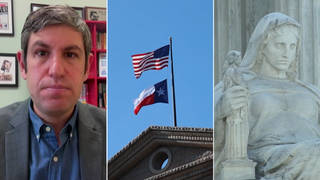
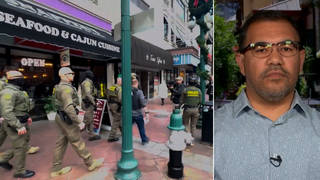
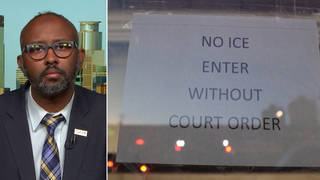
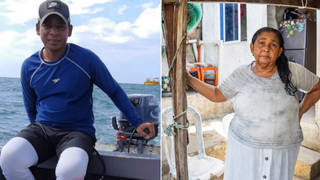





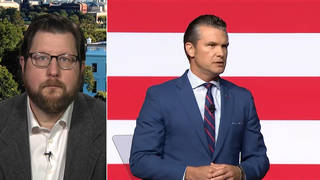
Media Options